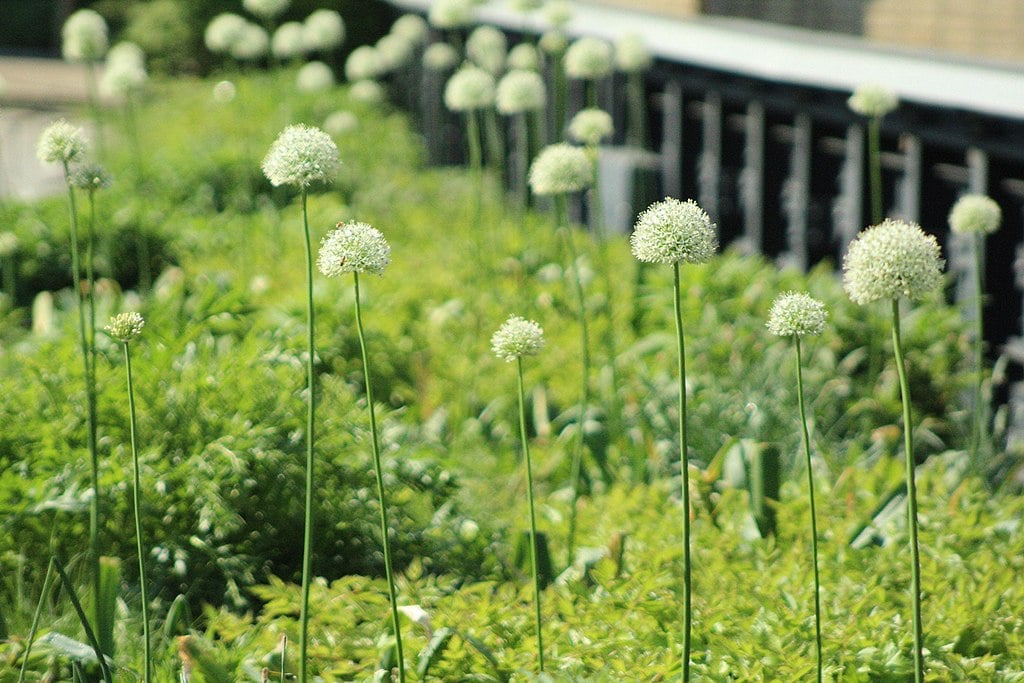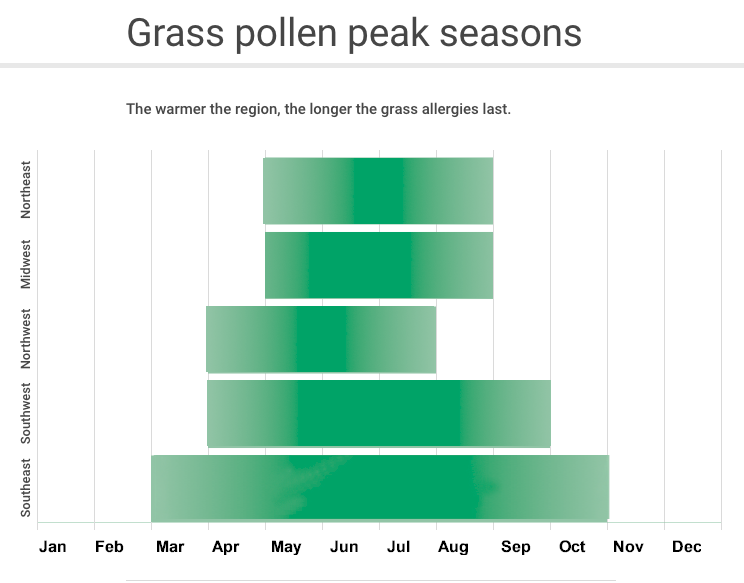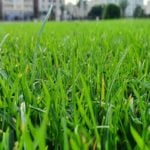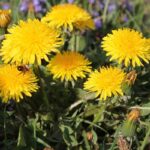
About 40 million Americans suffer from pollen allergies, and grass pollen allergies are among the leading causes of these seasonal sneezes.
Doctors call it seasonal allergic rhinitis, but its common name is hay fever.
Many types of irritants can trigger allergic reactions, including flecks of pet skin and dust mites. Hay fever is distinct from food allergies or indoor allergies, which can hit any time of the year. But pollen from trees, weeds and grass are a leading cause for seasonal allergies. Grass pollen season, which can begin in early to late spring, depending on where you live and how soon grass seeds begin to issue pollen. It lasts through early and late summer, and in warm climates sticks around to the fall.
Grass allergy symptoms
Symptoms of grass allergies include:
- Sneezing
- Runny nose
- Nasal congestion
- Red, itchy watery eyes
- Cough
- Allergic shiners (swollen, blue-colored skin under the eyes).
- Post-nasal drip
- In more serious cases, some chest tightness may occur.
- Occasionally symptoms also include hives or a rash, but that is rare, according to the American Academy of Allergy Asthma & Immunology (AAAAI).
What is grass pollen?
Grass pollen is microscopic particles that are the male reproductive agent of grasses. The average grass pollen particle is 30-50 microns across. A micron is one-millionth of a meter. By comparison, a human hair is about 75 microns across.
Their tiny size and weight allow the grass pollen particles to be carried long distances in the air and cause allergies far from the parent plant.
Types of grass that disseminate a lot of pollen include bromegrass, Timothy, Kentucky bluegrass, Russian wildrye and Orchard grass. In the South, Bermuda grass puts out a lot of pollen from spring to early summer and into the fall.
How grass pollen allergies work
Pollen turns us into red-eyed drip machines through a three-step process.
According to the AAAAI it happens like this:
- You inhale. Pollen enters the eyes, nose and lungs. As it does, it sensitizes the immune system.
- Your immune system reacts by producing specific antibodies.
- Now your body is set to react. The next time that pollen enters the body, the antibodies attach themselves to the pollen, causing histamine and other chemicals to be released. The allergic reaction can take several familiar, unpleasant forms.
Hay fever and allergies often run in families, one 2018 study found. Several rounds of research have found a genetic component to hay fever and other allergies, and the chance of inheriting allergy difficulties is higher if your mother has allergies.
Rarely fatal, but commonly miserable
About 40 million people a year suffer from hay fever in the United States, and 400 million worldwide. According to one study, allergic rhinitis resulted in about 811,000 missed workdays, 824,000 missed school days and 4.2 million reduced activity days.
How to know your pollen count
Avoiding allergies starts with taking precautions when conditions are ripe for pollen.
The best source of information is the AAAAI’s National Allergy Bureau. The bureau’s 84 counting stations in the United States are staffed by trained allergists who use air sampling equipment to collect and examine pollen and spores.
If you don’t live near one of the bureau’s stations, getting accurate pollen counts is hit or miss. Some allergists post counts as a courtesy, and some are more rigorous than others.
“I would caution you that many of the sources of allergen data are inaccurate and are based upon historical or regional extrapolations,” says Dr. Dennis Ledford, a Tampa allergist.
How to cope with grass allergies
Face it, grass is tough to escape. Estimates vary, but if combined all the lawns in the United States into a single unit, you’d have a lawn about the size of Indiana.
You can’t really prevent grass pollen from being in the air, but if you’re allergic you can take steps to minimize your exposure and avoid pollen peak times.
- If you’re allergic, avoid going out early in the morning (7-10 a.m.) or late afternoon (4 p.m. to 7 p.m.), as those are the hours when most grass varieties release their pollen. Hot windy days also have greater odds of pollen exposure. It’s better to go out after a rain when the rain has had a chance to knock the pollen out of the air.
- Keep your grass mown. Tall grasses seed out and the seeds are what release the pollen into the air.
- Wear a mask, goggles and gloves while mowing, or hire someone to do it.
- Put a mat by every door during allergy season to have a place to scrape off shoes.
- Take off shoes when you come in.
- If you’ve been outside, change clothes when you come in.
- Shower before going to bed so you wash off pollen that may linger on skin and hair.
- During times when you are suffering, avoid other irritants such as smoke and chemical fumes to give already strained mucous membranes a break.
- Change your home’s air filter regularly.
- Dust and mop regularly indoors.
- Get out of town. If your allergy has a peak season, and you can take a vacation away, do it.
- Your pets can bring in pollens when they have been outside. Keep a brush by the door and brush them off.
Protect allergic pets, too
And speaking of pets, dogs and cats can have the same allergies as their masters, though the allergy symptoms may show differently. Dogs may have watery eyes and stuffy noses, but usually, those symptoms are mild. With dogs, grass allergies are more likely to exhibit as itchy skin which results in dermatitis. Dogs scratch to relieve the itch, and can scratch off patches of skin.
Treatments for pet allergies range from over-the-counter chewable herb sticks to pills that only veterinarians can dispense. The Internet also has an abundance of natural remedies for itchy dogs.
Treatment of seasonal allergies
If symptoms are severe and over-the-counter remedies are not working on your itchy eyes, a trip to the allergist is called for. Tests, sometimes involving pricking the skin with needles containing various allergens, will pinpoint the cause of the symptoms. Allergy shots are a common treatment, as are nasal sprays.
Following clinical studies the Food and Drug Administration in 2014 gave approval to two new prescription drugs that protect against grass pollens from several allergy-inducing grasses:
Grastek treats allergies due to Timothy grass.
Oralair treats allergies triggered by pollen from Sweet Vernal, Orchard, Perennial Rye, Timothy, and 7 Kentucky Blue Grass Mixed Pollens.
Both are potent sublingual pills that dissolve under the tongue and can have strong side effects.
An additional product, Ragwitek, was OK’d for use in treating ragweed allergy.
Main image CC BY 3.0 via Wikimedia Commons






